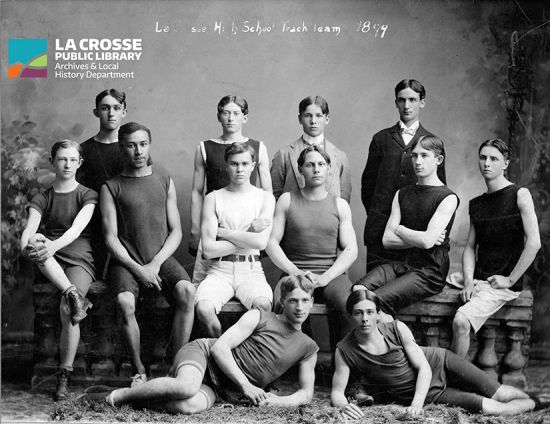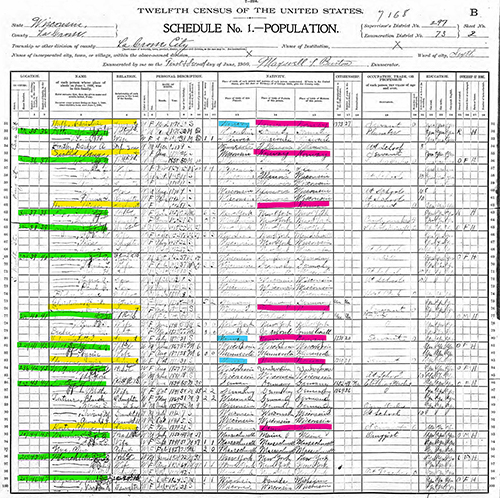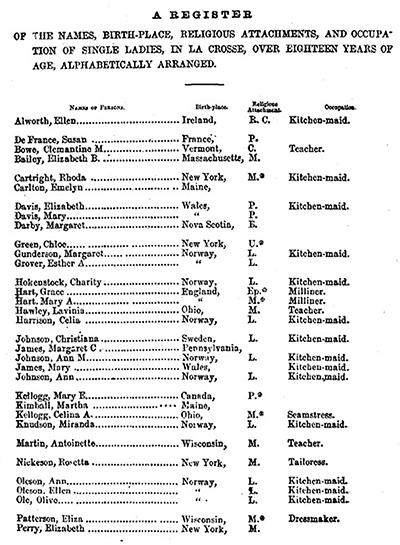
Working Women: Domestic Servants in La Crosse
(written by Meghan Hoefling, Archives staff)
As long as there have been wealthy families in large homes, there have been domestic workers supporting them. Domestic work has likely been a part of American life since the nation’s beginnings. Before the abolition of slavery in 1865, domestic workers were predominately enslaved individuals and occasionally contracted workers. Most domestic workers had pretty broad job descriptions. Referred to as ‘servants,’ these workers cooked meals, cleaned the home, nursed and cared for any children or elderly, and generally attended to any household needs. When slavery was abolished in 1865, domestic work was divided into three separate ‘sectors’ with different pay rates and responsibilities: cooking, laundering, and housekeeping. This was largely the work of newly emancipated Black women, who knew that increased specialization would be beneficial in the emerging wage economy.
In the late 1800s, large numbers of European immigrants arrived in the United States, and a lot of immigrant women entered the domestic workforce. In La Crosse, many young, single, Norwegian immigrants worked in domestic service. Census records for wealthy areas in La Crosse, such as the Cass-King residential district, give us insight into domestic workers during this period. The image below shows the 1900 U.S. Federal Census, and documents residents living on Cass, King, and South 9th streets in La Crosse. Households are highlighted in green, and girls listed as ‘servants’ are highlighted in yellow. Over half of the households in this area employed a servant in their home. The blue highlights show domestic workers that were born outside of the United States, and the pink highlights indicate servants with parents who were immigrants. This image shows that 100% of the women working as servants in this area were, at most, first-generation Americans. Almost half were immigrants themselves.
Click image for detailed view
According to the federal census aggregate book on population characteristics, there were 699 females and 76 males working as Servants or Waiters in La Crosse in 1900. This category of work was the second highest employer of women, following those working Domestic and Personal Service which employed 1,017 females. In 1900, there were 11,629 women living in La Crosse, meaning that almost 10% of women worked in domestic service.
City directories are a great source of information on domestic work in La Crosse. These can tell us the names of women employed in domestic service, as well as the homes that employed them. Domestic workers began to be recorded in the La Crosse City Directory in 1884, but it wasn’t until 1888 that the practice became consistent. The image below is a screenshot from the 1888 La Crosse City Directory. The women listed here are all unmarried and employed (except for Mary Larsen) in domestic service. The addresses following ‘domestic’ indicate where the women worked in La Crosse. Notice the last name Larson, or Larsen, a common Scandinavian surname.

1888 City Directory
La Crosse city directories and census records tell us a lot about domestic work in the late 19th-century, but what about the mid-1800s? La Crosse was well-established by the 1850s, and by this time, single women were already employed in domestic service. In 1854, Rev. Spencer Carr, a Baptist pastor in La Crosse, published A Brief Sketch of La Crosse, Wisc’n. In this booklet, Carr explains the history of La Crosse and what life was like for residents in the 1850s. A Brief Sketch was likely meant to encourage outsiders to move to the city and the end of the sketch provides a list of the eligible bachelors and bachelorettes in the growing city. The image below page 27 of Carr's booklet, showing a register of the “single ladies in La Crosse.” Notice the birthplaces for the women, and the predominance of “kitchen-maid” as an occupation.
A Brief Sketch of La Crosse, Wisc’n, p. 27 - click image for detailed view
While census records and city directories provide us with a broad picture of domestic work in La Crosse, they can’t inform us about the lived experiences of these women. Unfortunately, we really don’t have any first-hand accounts from domestic workers. Most of the stories related to individuals employed in domestic work come from newspaper accounts, which frequently focused on tragedy or scandal. The following stories give us a glimpse into the lives of domestic workers in La Crosse.
Maggie Eckert

12 November 1884 Republican & Leader p3
Very little is known about Maggie Eckert’s life apart from her tragic death. In 1884, 21-year-old Maggie began working in the home of Frank Burton. Just a few months after Maggie’s employment began, Frank, a prominent political figure, was assassinated during a parade downtown. Maggie continued working for Frank’s wife, Abby Burton and her father Captain Isaac Moulton after Frank’s death.
In the Fall of 1884, La Crosse had seen a recent string of burglaries. This increase, and the resulting fear for city residents, likely inspired a prank by Maggie and three of her friends planned for the night of November 11, 1884. At around 9pm, the women walked over to the house of Charles W. Bunn at 1334 Cass Street. Mr. and Mrs. Bunn were thought to be spending the evening at the opera house, meaning that the women employed at 1334 Cass would be the only ones in the home. Maggie and the girls began creeping around the house, turning doorknobs and lifting windows in an attempt to frighten their friends inside. But Mr. and Mrs. Bunn didn’t go to the opera house. Instead, Mr. Bunn sat reading in his sitting room. After hearing the noises from outside the house, he loaded a shotgun, and waited. As Bunn heard steps approaching his front door, he was convinced that a burglary was taking place. He stepped into the hallway, and fired a shot through the door’s glass panel. Maggie was shot through the heart. Mr. and Mrs. Bunn brought her into their home, where she quickly succumbed to her injuries. Mr. Moulton, Maggie’s employer, was notified of the accident and drove to the Fifth Ward, which in 1884 encompassed the area north of the La Crosse River, to inform Maggie’s two brothers. Two days later, a coroner’s inquest was held. The jury concluded that the death was accidental, and her funeral was held on November 13, 1884. She is buried in the Catholic Cemetery and her stone reads “Maggie Ecker, dau. of Peter & Clara, aged 21 yrs.”
Corilla Douglas
Corilla Douglas was a Black woman born in Tennessee, likely around 1856. According to the census, she lived and worked in Carrol, Tennessee in 1900 for the Cauley family. Corilla first appears in La Crosse city directories in 1907 as a domestic worker at 123 N. 14th St. However, by 1909, Douglas is listed as the domestic worker for 1419 Cass St, now known as the ‘Castle on Cass.’ Jessie Holway, widow of lumber baron N.B. Holway, was the head of the household at the time, and the home was also occupied by her sons and their wives. Corilla worked in the home until 1920, when the Holways sold 1419 Cass to the Catholic Diocese and moved to 1205 Main St. Corilla moved along with them, and worked in the home as a cook until 1928. Corilla presumably moved back to Tennessee, where she died on August 25, 1936 of old age. In a scrapbook from one of Jessie Holway’s sons, Elmore, there is a picture of Corilla outside the home at 1419 Cass St.
Corilla Douglas, ca 1910s
Petra Solberg
According to city directories, Petra Solberg began working as a domestic servant in La Crosse in 1897, at 120 S. 14th St. She worked there until her father, Lars’ death in 1902. She seems to have taken a break from working for the next few years, and resided with her family at 402 Oakland St. In 1911, she returned to domestic work at 1136 King St, the home of Samuel Hyde. Also working for the Hyde family was a man names Henry Liso, who was employed as a coachman.
Liso was married with children, but he and Petra began an affair which resulted in a pregnancy. In November 1914, Petra planned to go to Minneapolis to have the baby, and Henry was to provide her with $300 for the journey. However, when Petra and Henry met to exchange the money, Petra demanded $500. The two began to argue, and Henry pulled a hammer from his back pocket and struck Petra repeatedly in the head. She was 31 years old. Liso confessed to the murder five days later, and spent twelve and a half years at Waupun before receiving a pardon from Governor Fred Zimmerman.

Petra (left), Louise, and Anna Solberg
Petra’s story is a devastating one, but her story, along with Maggie Eckert’s, cue us in to the social relationships among those working in domestic service.
Anna Poage
Anna, also known as Annie, Coleman Poage was born in Missouri in 1853, and came to La Crosse in 1884 with her husband James H. Poage. Both Anna and James had been enslaved. The couple was married in 1868, and by the time they migrated to La Crosse, they had three children: Lillie (also known as Lulu Belle), Nellie, and George. Once in La Crosse, James began working as a coachman and horse tender for Albert Pettibone. Anna also worked for the Pettibones as a domestic servant and cook. James soon became ill and died of tuberculosis in July of 1888, leaving Anna as the primary provider for the Poage family. Anna gained a reputation as a trustworthy domestic worker amongst La Crosse’s wealthy families. After working for the Pettibones, Anna became a cook and stewardess (in charge of other domestic workers) for Jason C. Easton at 1305 Cass St. At the time, the Easton estate was the largest residential property in the city, and Anna was responsible for running it. She also continued to raise her children, George and Nellie (Lulu had died in 1887). George and Nellie both attended La Crosse High School in the 1890s. Nellie graduated in 1897, then went on to attend the Lincoln Institute in Jefferson City, Missouri. George was the salutatorian of the class of 1899. He attended the University of Wisconsin in Madison, where he joined the track team. Five years later, George competed at the 1904 St. Louis Olympics, where he won two bronze medals and became the first African American Olympic medalist.

George Coleman Poage (2nd from left, middle row) with the La Crosse High School Track Team, 1899
Hopefully, the stories of Maggie, Corilla, Petra, and Anna have provided a glimpse into the experiences of domestic workers in the late 19th- and early 20th- centuries in La Crosse. By the end of WWI, immigration to the United States had significantly slowed, and many women began working wartime jobs. This led to a shortage of labor for domestic work, an issue that became known as ‘the servant problem.’ In the three decades after WWI, the servant problem persisted, ultimately resulting in the obsolescence of domestic servitude.
La Crosse Tribune, July 13, 1912 p5. A comic proposes a solution to the ‘servant problem’




